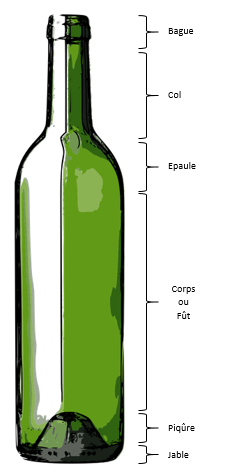Why does the wine bottle have a hollow ? Why the standard wine bottle size is 75 cL and is green ? You will know everything about the bottle of wine !
For this article I was inspired by a Russian friend with whom I was able to chat over drinks. After a moment of hesitation, she started to ask me the question that had been burning her tongue for a few minutes. "Jean-Nicolas, I would like to ask you something. In Russia, it is often said that to find a good bottle of wine, you just have to flip them over and compare the bottoms. The deeper the butt, the better the wine. Is this a good technique ? "
Why a bottle of wine has a concave bottom ?
The story goes back to the 4th century. This bottom called "sting" - piqûre in French - is the best way wine producers have found to have a stable bottle.. The use of a flat bottom did not allow a good balance of the bottle. This bottom is also convenient for the service of so-called wine “with pliers”, putting your hand under the bottle and pushing it inside the base.
Most champagnes and other sparkling wines have a deeper bite, because according to the traditional method of vinification, bottles are put on spikes, that is, the neck down, on top of each other.
However, there's a famous exception to this sting : Roederer champagne cuvée Cristal. In 1876, Tsar Alexander II ordered flat-bottomed bottles. "Why this eccentricity ? »You will tell me. He was just afraid that opponents would hide explosives in the sting.
The depth of the bottom therefore plays no role in the quality of the wine.

Why is a bottle of wine 75cl ?
The reason why wine bottles do 75 cL and not 1 liter dates back to the 19th century. At that time, the United Kingdom was the main buyer of Bordeaux wines. You know it, the English like to do things differently and their unit of measurement was the "imperial gallon" which is equivalent to 4,54609 liters. In order to not don't bother too much with conversions, the winegrowers decided to use barrels of 225 liters, that is to say 50 gallons rounding to transport wine. The format of 225 liters has the advantage of corresponding to 300 bottles of 75 cL, which makes calculations much easier. One gallon is 6 bottles, reason why, even today we use cases of wine sold by 6.
Let's recap : 1 barrel = 50 gallons = 50 crates = 300 bottles (75 cl)
Why is the wine bottle green ?
The explanation is simple : wine needs to be protected from light and more specifically UV rays which can alter its taste and color. In addition to this protection “minimal”, wine should be stored in the dark, even in complete darkness so as not to disrupt the aging process. Neons are also to be avoided !
Small summary of "bottle" vocabulary
 |
| French Wine Bottle Vocabulary |
- Why does the stemmed glass have a stem ?
- What are the names and sizes of wine bottles ?
- What does Mariannes mean on wine bottles? ?
- How long can I keep a bottle of wine open ?
Do not hesitate to let me know your impressions of your experience in the comments. You can also follow your wine blog with Instagram.



Like that, that doesn't mean anything to me. Can you post a picture of the bottle jable (si c'est encore possible) on the blog's Facebook page ? = https://www.facebook.com/Beaux.vins/
Hello, could you identify a bottle with a marking on the rim : 76 , an S in a rhombus, followed by 76 et FF avec un marquage style braille et enfin un "5"
Merci d'avance.
76 cl total capacity
S in rhombus : Saverglass glassware
and the FF 5 probably the model
Hello then finally green bottle but why not black bottle ? 🙂
Hello Julia,
The glass was colored by the addition of different mineral oxides such as iron oxide for green.
I have not found any official information to know the date of the invention of the opaque black bottle – type Freixenet -…
But I don't think I'm wrong in saying that this invention is rather recent in the history of the wine bottle.
Little more, an opaque bottle also has the disadvantage of not allowing the color of the wine to be distinguished by transparency…
Hello German wines that have no hollow are of quality.
Bonjour Erimos,
the purpose of this article was not to say that a bottle of wine without “hollow” was less good, but that there is no relationship between the depth of the bite and the quality of the wine.